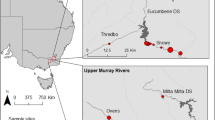Abstract
We investigate using relative amounts of prey DNA recovered from pinniped faeces to obtain diet composition data. Faeces were obtained from captive sea lions being fed a diet containing three fish species (50%, 36% and 14% by mass). Real-time PCR was used to quantify mtDNA in undigested tissue and in the faecal samples. The percent composition of fish mtDNA extracted from tissue corresponded reasonably well to the mass of fish in the mixture. In faecal samples the absolute amount of fish mtDNA recovered varied 100-fold, but the percent composition of the samples was relatively consistent (57.5 ± 9.3%, 19.3 ± 6.6% and 23.2 ± 12.2%). These results indicate there are prey-specific biases in DNA survival during digestion. However, the biases may be less than those commonly observed in conventional diet studies.


Similar content being viewed by others
References
Bowen WD (2000) Reconstruction of pinniped diets: accounting for complete digestion of otoliths and cephalopod beaks. Can J Fish Aquat Sci 57:898–905
Casper RM, Gales NJ, Hindell MA, Robinson SM (2006) Diet estimation based on an integrated mixed prey feeding experiment using Arctocephalus seals. J Exp Mar Biol Ecol 328:228–239
Deagle BE, Tollit DJ, Jarman SN, Hindell MA, Trites AW, Gales NJ (2005) Molecular scatology as a tool to study diet: analysis of prey DNA in scats from captive Steller sea lions. Mol Ecol 14:1831–1842
Hogg RV, Tanis EA (2005) Probability and statistical inference, 7th edn. Prentice Hall, New Jersey
Jarman SN, Deagle BE, Gales NJ (2004) Group-specific polymerase chain reaction for DNA-based analysis of species diversity and identity in dietary samples. Mol Ecol 13:1313–1322
Kvitrud MA, Riemer SD, Brown RF, Bellinger MR, Banks MA (2005) Pacific harbor seals (Phoca vitulina) and salmon: genetics presents hard numbers for elucidating predator–prey dynamics. Mar Biol 147:1459–1466
Laake JL, Browne P, DeLong RL, Huber HR (2002) Pinniped diet composition: a comparison of estimation models. Fish Bull 100:434–447
Miller FJ, Rosenfeldt FL, Zhang CF, Linnane AW, Nagley P (2003) Precise determination of mitochondrial DNA copy number in human skeletal and cardiac muscle by a PCR-based assay: lack of change of copy number with age. Nucleic Acids Res 31:e61
Parsons KM, Piertney SB, Middlemas SJ, Hammond PS, Armstrong JD (2005) DNA-based identification of salmonid prey species in seal faeces. J Zool 266:275–281
Purcell M, Mackey G, LaHood E, Park L, Huber H (2004) Molecular methods for the genetic identification of salmonid prey from Pacific harbor seal (Phoca vitulina richardsi) scat. Fish Bull 102:213–220
Sinclair EH, Zeppelin TK (2002) Seasonal and spatial differences in diet in the western stock of Steller sea lions (Eumetopias jubatus). J Mammal 83:973–990
Symondson WOC (2002) Molecular identification of prey in predator diets. Mol Ecol 11:627–641
Tollit DJ, Wong M, Winship AJ, Rosen DAS, Trites AW (2003) Quantifying errors associated with using prey skeletal structures from fecal samples to determine the diet of Steller’s sea lion (Eumetopias jubatus). Mar Mamm Sci 19:724–744
von Wintzingerode F, Gobel UB, Stackebrandt E (1997) Determination of microbial diversity in environmental samples: pitfalls of PCR-based rRNA analysis. FEMS Microbiol Rev 21:213–229
Acknowledgements
We thank Nick Gales, Simon Jarman, Mark Hindell and Andrew Trites for valuable advice and their help in the initiation of this project. The project was funded by the Australian Antarctic Division and also supported by the North Pacific Marine Science Foundation through the North Pacific Universities Marine Mammal Research Consortium. We thank the staff at the Vancouver Aquarium Marine Science Centre and members of the UBC Marine Mammal Research Unit for assistance with sample collection. Paige Eveson provided helpful statistical guidance. Work was undertaken in accordance with UBC Animal Care Committee guidelines.
Author information
Authors and Affiliations
Corresponding author
Rights and permissions
About this article
Cite this article
Deagle, B.E., Tollit, D.J. Quantitative analysis of prey DNA in pinniped faeces: potential to estimate diet composition?. Conserv Genet 8, 743–747 (2007). https://doi.org/10.1007/s10592-006-9197-7
Received:
Accepted:
Published:
Issue Date:
DOI: https://doi.org/10.1007/s10592-006-9197-7




